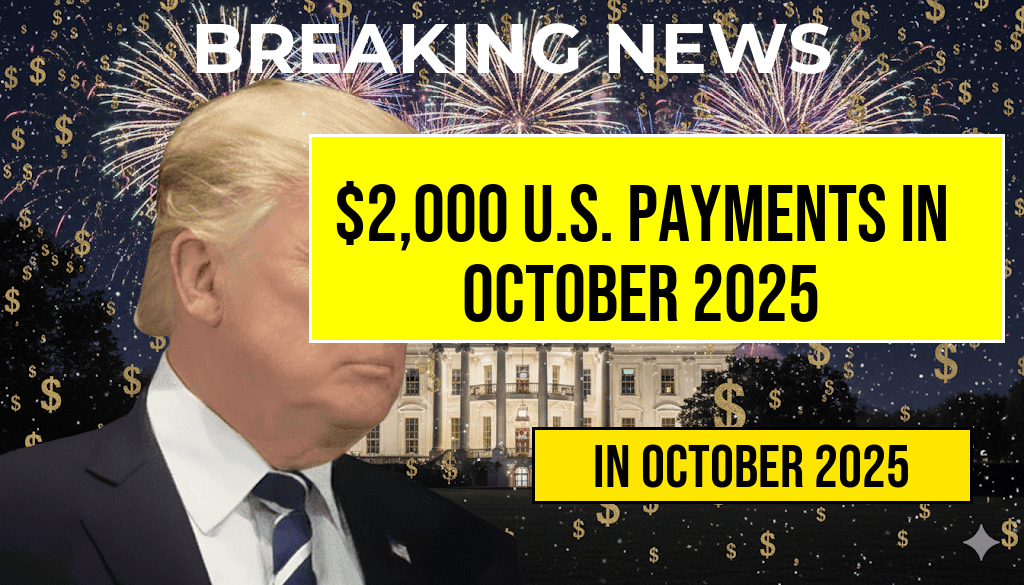Starting October 2025, eligible U.S. citizens are set to receive a $2,000 direct deposit from the federal government, marking a significant development in ongoing efforts to provide financial relief and stimulate economic activity. This initiative, authorized through recent legislative measures, aims to support households nationwide amid ongoing economic adjustments and inflationary pressures. The payments are scheduled to be distributed through the Internal Revenue Service (IRS), which will manage the eligibility verification and payout process. While the details surrounding eligibility criteria, payment timelines, and IRS guidelines are still being finalized, experts anticipate that millions of Americans will benefit from this targeted financial assistance. This article explores the key aspects of the upcoming payments, including who qualifies, when payments will be made, and how the IRS is planning to administer this sizable financial outreach.
Understanding the $2,000 Direct Deposit Program
The $2,000 direct deposit initiative is part of a broader effort to bolster household finances and encourage consumer spending. Unlike traditional stimulus payments, this program is targeted towards specific income groups and demographic categories, aiming to ensure that aid reaches those most in need. The program’s design reflects recent legislative priorities focused on economic stability and social support, with the IRS playing a central role in disbursing funds efficiently and securely.
Eligibility Criteria
The IRS has outlined several preliminary eligibility parameters, which are subject to refinement as the implementation process unfolds. Key factors influencing eligibility include:
- Income Thresholds: Households with an adjusted gross income (AGI) below certain limits, typically set around $75,000 for individuals and $150,000 for married couples, are expected to qualify.
- Tax Filing Status: Filers who have submitted recent tax returns, particularly those claiming standard deductions or qualifying for the Earned Income Tax Credit (EITC), are likely to be prioritized.
- Residency Requirements: U.S. citizens and resident aliens who have established domicile within the country are eligible for the payments.
- Bank Account Information: The IRS will utilize existing tax and banking data to identify eligible recipients, with direct deposit as the primary payout method.
Individuals unsure about their eligibility can consult the official IRS guidelines or use the IRS’s online portal once available for eligibility verification.
Payment Schedule and Distribution Timeline
The IRS plans to initiate the first round of payments in early October 2025, with subsequent deposits scheduled throughout the month. Based on preliminary reports, the distribution schedule will likely follow a staggered approach, prioritizing taxpayers with direct deposit information on file. Those without bank accounts or who opt for paper checks will experience a delay, with payments expected to reach them by mid to late October.
| Week | Recipients | Payment Method | Expected Delivery |
|---|---|---|---|
| Week 1 | Taxpayers with direct deposit info on file | Direct Deposit | October 1–7 |
| Week 2 | Remaining eligible filers with direct deposit | Direct Deposit | October 8–14 |
| Week 3 | Paper check recipients and those without bank info | Mail Check | October 15–31 |
IRS Guidelines and Application Process
The IRS intends to leverage existing tax data to streamline the distribution process. Eligible individuals will not need to submit a new application if their information remains current. However, those who do not have their banking details on file or who wish to update their information must use the IRS’s online portal or contact support to facilitate direct deposit setup.
Furthermore, the IRS emphasizes that recipients should remain vigilant against scams related to these payments. The agency has issued warnings against unsolicited calls or emails requesting personal information, reiterating that official communications will only come through trusted IRS channels.
For additional guidance, individuals can refer to the official IRS website, which will host detailed FAQs and updates on the program’s progress.
Implications and Public Response
The announcement of a $2,000 direct deposit has generated considerable interest among policymakers and the public alike. Advocates view it as a targeted, timely intervention that can provide immediate relief to struggling households, bolster local economies, and reduce financial insecurity. Critics, however, question the program’s long-term sustainability and its potential impact on inflation and national debt levels.
Economists suggest that while such direct payments can stimulate spending, they should be part of a broader strategy that includes sustainable fiscal policies and economic reforms. As the program rolls out, monitoring its effects will be crucial for assessing its efficacy and informing future initiatives.
With the October payout approaching, recipients are advised to stay updated through official IRS communications and ensure their banking information is current to receive funds without delay. As the federal government continues to refine its approach, this initiative marks a notable step toward more targeted financial support for American households.
Frequently Asked Questions
Question
Who is eligible to receive the $2,000 direct deposit in October 2025?
Question
What are the eligibility requirements for U.S. citizens to qualify for the payment?
Question
When is the payment schedule for the $2,000 deposits, and how will recipients be notified?
Question
How does the IRS determine who qualifies for the direct deposit, and what guidelines should recipients follow?
Question
Are there any additional steps or documentation needed to receive the $2,000 payment?

Leave a Reply